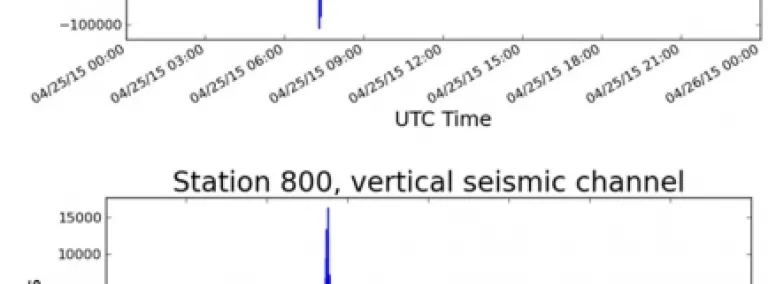DUGL sees Nepalese earthquake
On April 25, 2015, a devastating earthquake struck Nepal; the magnitude was read by DUGL seismometers at Sanford Lab.
On Saturday, a devastating earthquake struck Nepal, one of the poorest countries on Earth. The 7.8 magnitude temblor, followed by a 6.7 magnitude aftershock, destroyed villages and towns, trapped hundreds on Mt. Everest, and took the lives of more than 4,000 people. Many news sources say that number is expected to grow as rescuers reach remote areas.
For about 50 million years, the Indo-Australian Plate has been pushing itself beneath the Eurasian Plate, a collision that gave rise to the Himalayan Mountains. As the plates continue to collide, pressure builds until finally an earthquake occurs to relieve the stress. The Indo-Australian Plate is pushing under the Eurasian Plate at a rate of nearly 2 inches per year.
"This is one of the fastest convergences on Earth," said Victor Tsai, Assistant Professor of Geophysics at the California Institute of Technology. "The collision is causing the Himalayas to grow taller every year."
Tsai is part of the Deep Underground Gravity Laboratory (DUGL). In November, the team installed 15 seismometer stations on several levels of Sanford Lab from the 300 to the 4850. Another four were placed on the surface. Placed in a grid, the seismometers monitor ground motion, giving researchers a 3-Dimensional seismic picture, Tsai said.
The earthquake and aftershocks that struck Nepal were recorded at every station. Tsai said the instruments operated exactly as expected. "They can detect ground movement with velocities of less than a micron per second. Our array is unique in how deep our instruments are, which means less noise and makes the earthquake readings cleaner."
One of DUGL's goals is to inform the design of future gravitational wave detectors, said Vuk Mandic, Assistant Professor of Physics and Astronomy at the University of Minnesota. "Gravitational wave detectors are very sensitive to seismic noise, because it creates very small vibrations and rock movement. This causes small fluctuations in gravity," Mandic said.
"Data collected by DUGL's seismometers will help us understand the structure and directionality of the seismic noise underground, which we will then use to design future detectors."
Several aid agencies around the world are preparing humanitarian missions to Nepal. The New York Times compiled a list of agencies that are accepting donations to help in the rescue efforts. To learn more, go to:
http://www.nytimes.com/2015/04/27/world/asia/where-to-donate-for-nepal.html?_r=0
